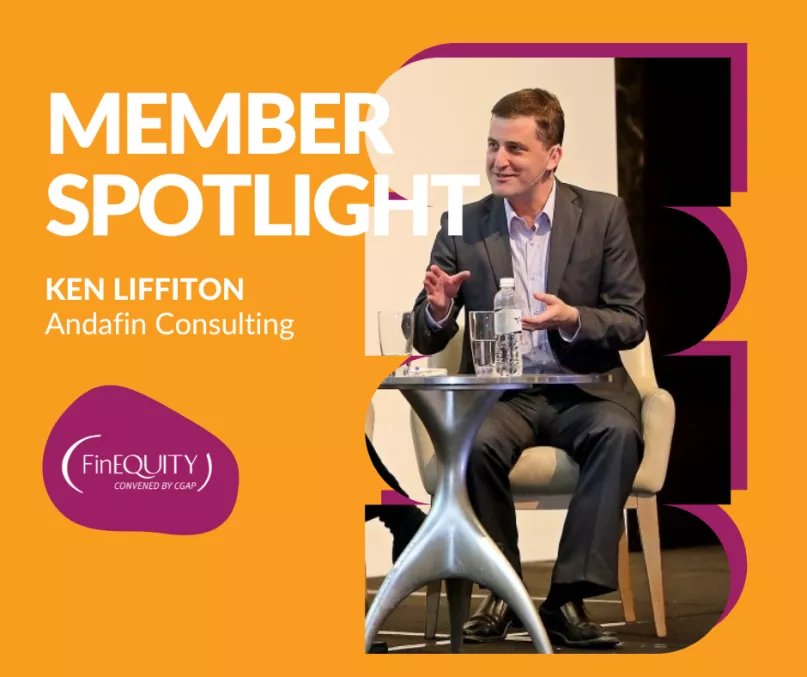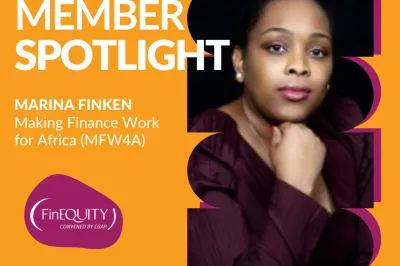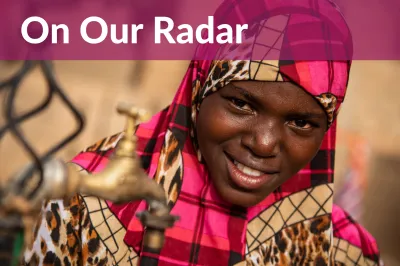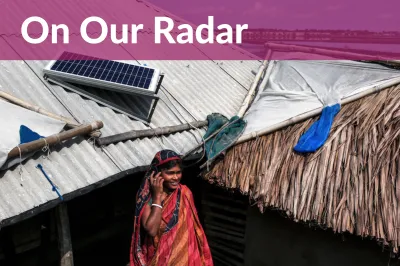Member Spotlight: Ken Liffiton

Ken Liffiton, Managing Director of Andafin, sat down with us to discuss the role of data analytics in financial inclusion and economic empowerment, how the broader women’s financial inclusion community can support financial institutions and more.
FinEquity: Tell us a little bit about yourself. A fun fact? Something that might surprise most people? Your superpower?
Ken Liffiton: I’m the managing director of Andafin, which provides consulting and strategic data analytics services to MSME financial institutions. Our technology platform uses desensitized (anonymous) customer data along with transaction data to generate detailed insights on customer behavior, which we combine with consulting services to bring strategic insights to leaders of the financial institutions. In many cases, our insights relate to how they can better serve women customers.
I’ve been largely based in Vietnam since 2011; my experience there, aside from launching Andafin, includes finding out-of-the way places by motorbike, teaching corporate strategy classes and launching financial products for low-income workers.
A fun fact is that launching financial products with a team of Vietnamese bankers means embracing the customs of the local financial services industry. For example, shutting down the office to take a refreshing nap after lunch, and then taking the staff to eat snails and sing karaoke after work, both skills which I improved greatly in Vietnam.
FinEquity: How did you get involved in the women’s financial inclusion space? What drew you to working with financial institutions?
Ken Liffiton: I started my career at Grameen Foundation as it went through a period of rapid growth nearly 20 years ago; at the time major focus areas were facilitating MFIs’ access to capital and helping to build their technical capacity. I was focused on the second part, specifically in technology. A typical technology problem I worked on back then was “our MFI has a hundred thousand clients, and all their transactions are in these paper ledgers; please help!” So, “digitization” had a very different meaning than it does today.
While I was working on MFIs’ technology problems, I also got to visit the field and meet the MFIs’ women clients. There I saw the effectiveness of microfinance, and especially got to know the stories of the clients and MFI field staff. While the products and technology are a bit different today, the core concepts remain the same, but we have far more data available to understand what is going on in a portfolio.
My technology work eventually shifted into data analysis, and I saw the potential of cloud computing and a dedicated team to do bigger things with data than I could achieve on my own. So, in 2015 I started Andafin. Most of our work has a gender component, whether a project starts out with a “gender-focused” scope or not.
My technology work eventually shifted into data analysis, and I saw the potential of cloud computing and a dedicated team to do bigger things with data than I could achieve on my own.
By advising financial institutions, Andafin addresses the supply side of financial inclusion, but on the demand side there are opportunities to make a difference as well. I’m on the board of a small nonprofit that focuses on women and girls’ education in Vietnam’s Mekong Delta region; building upon the organization’s successful scholarship program, I gathered volunteers to launch a suite of educational programs including financial literacy.
All our teachers and facilitators are role models as well – Vietnamese women with successful professional careers who travel to the Mekong Delta to teach university women and high school girls about financial literacy, effective communication and career skills. The discussions that ensue in that environment often go much deeper than the course topics.
FinEquity: You’ve been working on data analytics for financial services for more than a decade; can you tell us a bit about that work and how you’ve seen it shift over the last ten years? What are you working on that makes you excited?
Ken Liffiton: The game-changer for our data analytics work has been the rise of cloud computing; that development made Andafin possible. Previously, the resources necessary for us to analyze hundreds of millions of transactions would have been prohibitively expensive, but with on-demand computing power we are able to immediately scale our capabilities to our clients’ demands. If we need a hundred or more instances (computers) to get answers about a large data set, we can access those resources nearly instantly.
Meanwhile at financial institutions, I’ve seen a growing interest in using data for strategic decision-making, and awareness of what is possible. There’s plenty more to be done there, but it’s an encouraging trend. Especially with increased digitization, there is more we can learn from data than ever before.
During the COVID-19 pandemic we focused on technology upgrades to allow us to process large datasets even more efficiently than before, and to deliver results interactively. To date Andafin has analyzed well over a billion customer transactions (using desensitized data); I’m excited to see what customers will tell us in the next billion transactions.

FinEquity: Andafin asserts that women’s growing use of financial services in many countries calls for new and improved products to better address their needs – how have you seen this play out for the providers and institutions you work with?
Ken Liffiton: Sometimes we see products that need improvement in general – this means fixing issues that harm all customers but may disproportionately affect women. For example, in microinsurance analysis we may find that a product’s claim and payout ratios are low, in part because customers may not be aware of claim procedures or even of the insurance policy itself. While such a problem affects all customers, the solution should include research into women’s usage of the product.
In other cases, a new product – or a women’s market strategy – is a better solution. For example, we worked with VPBank in Vietnam to help them better understand their SME credit card business; while this was not specifically a gender-focused project, one of our findings was that women-owned SMEs had higher retention and lower NPLs than men-owned SMEs. Based on our findings, VPBank launched a women’s market strategy with their Women Entrepreneur credit card as its centerpiece. FinEquity member CARE Ignite later worked with VPBank to build upon this strategy and further develop the bank’s WSMEs products. (FinEquity has presented webinars on both Andafin’s and CARE’s engagements with VPBank.)
FinEquity: How do those experiences shed light on where FSPs and financial institutions should be focusing? And where the broader women’s financial inclusion community should be focusing?
Ken Liffiton: Financial institutions generally have a wealth of underutilized data right under their noses – there is a lot to be learned from customer transactions and demographic data, but many banks lack the resources to analyze this data. This is partly a technical challenge, but also a mindset challenge we have seen in larger financial institutions that have established BI departments generating a lot of analysis, but without a clear link to strategy. How to translate data into insights that drive action is an area that can get overlooked – this was a topic we covered in our FinEquity webinar, where often “less is more” and we don’t want to see more analysis just for its own sake. A hundred metrics might be available, but the handful that will drive change are where we want to focus leaders’ attention.
A hundred metrics might be available, but the handful that will drive change are where we want to focus leaders’ attention.
Data analysis can in many cases help a financial institution make the case for the women’s market, or see gender differences in product usage, but going a layer deeper, segmentation and behavioral clustering within genders reveals more opportunities. Customers aren’t purely a reflection of their gender, and the “average” female or male customer should be seen as more of a benchmark than an actual customer we should be trying to develop products for.
The broader women’s financial inclusion community can support financial institutions in a couple of areas related to data:
- Help financial institutions build their data analytics and decision-making capacity. In microfinance institutions there may be little data usage beyond the basic reporting available from the core banking system, and therefore customer segmentation may be very limited in practice. Commercial banks are more likely to have a wealth of analytics tools and market research, but still need help turning their internal data into strategic insights that will complement their market research and segmentation activities.
- Gender data still needs improvement in some cases. While we are seeing fewer cases of financial institutions that collect incorrect or incomplete gender data than we did in the past, fintechs in some cases still lag behind other FSPs. Meanwhile, gender is more difficult to define for SME products; we were able to help VPBank understand their SME card product by gender because they had sufficient data to tag the SMEs by gender (according to the IFC definition), but this is only possible with data on shareholders and key officers of the company.
FinEquity: What are your top priorities in 2022 for your work?
Ken Liffiton: First, it’s hard to overstate how exciting it has been to get back out into the world and have face-to-face meetings with others involved in financial inclusion. Right now, I’m in Cambodia where I’ve learned a lot from people on the ground who know the sector best.
Second, we are looking at how we can not only analyze a single financial institution’s internal data, but how we can draw data from multiple institutions to produce better insights that benefit all the institutions involved. This could involve benchmarking institutions’ gender performance as well as financial performance.
And as always, we’re on the lookout for interesting datasets that help us better understand customers’ financial behavior. Especially where we have multiple products and/or data-rich products such as credit cards or mobile money, we can use behavioral clustering to get a better idea of what different groups of customers aim to achieve with the products.
And as always, we’re on the lookout for interesting datasets that help us better understand customers’ financial behavior.
FinEquity: Do you have a success story from your work with Andafin you’d like to share? (An occasion where you felt that you or your organization was making a real impact in the lives of women?)
While our quantitative analysis work is typically one step removed from customers’ lives (qualitative research can be a great follow-up to understand the “why” behind behavior), sometimes opportunities for impact are already apparent when we complete our analysis.
Aside from the VPBank example, another that comes to mind is from a women-focused microfinance institution we worked with in the Middle East. The management expressed concerns about multiple borrowing, and customer attrition was a problem. Our analysis found that due to a high inflation rate, the average customer was seeing her loan size drop below her working capital needs as she progressed from one loan cycle to another, and that customers with the smallest loans in each cycle were the most likely to drop out. The MFI therefore made sizeable increases in loan sizes to keep up with inflation and customers’ capital needs.
We also analyzed the MFI staff’s performance and found that women loan officers were overall more productive than their male counterparts; the MFI agreed to do more to promote women, considering them for branch manager positions for the first time.
FinEquity: What can our members connect with you about/what can they ask you about?
Ken Liffiton: There is certainly plenty we can talk about in relation to data and women’s financial inclusion, for example:
- How to improve data usage in a financial institution, and particularly how to ensure better gender data
- The opportunities that lie in banks’ internal data to better understand customers
- What we can do with machine learning to discover more about customer behavior
- Challenges different types of financial institutions face in making better use of their data
I’d also be interested to hear questions about women’s financial inclusion that members feel have not been sufficiently addressed with data – those may be opportunities to brainstorm what could be different about data collection and analysis to get us closer to answers, perhaps combining quantitative and qualitative analysis more rigorously.
I’d be interested to hear questions about women’s financial inclusion that members feel have not been sufficiently addressed with data – those may be opportunities to brainstorm what could be different about data collection and analysis to get us closer to answers, perhaps combining quantitative and qualitative analysis more rigorously.
And of course, as consultants we’re always interested to look at strategic questions related to women’s financial inclusion – whether that’s making the case for the women’s market, data-driven product development, or assessing an existing strategy and product line.
FinEquity: What role does FinEquity play in your work? Where do you see value in this community? How has being a member shaped your work?
Ken Liffiton: FinEquity has been great for both the networking opportunities and to get a broader perspective on how our work fits into the overall picture of women’s financial inclusion.
My first (and sadly last!) offline networking opportunity with FinEquity was the 2019 conference in Singapore. We had some great discussions there related to both data analytics and topics I was less familiar with. Online discussions on topics adjacent to our work, such as about social norms, have been very interesting and informative as well. (And even in quantitative analysis, we can see social norms in action – usage of credit cards or mobile money by channel and time of day is a good example, especially in relation to women’s mobility.)
One of my first real-life meetings this year was with a fellow member I met at FinEquity's 2019 annual meeting, a sign that we’re gradually returning to the offline world. I’m looking forward to meeting and learning from the rest of the FinEquity members at a future event.


